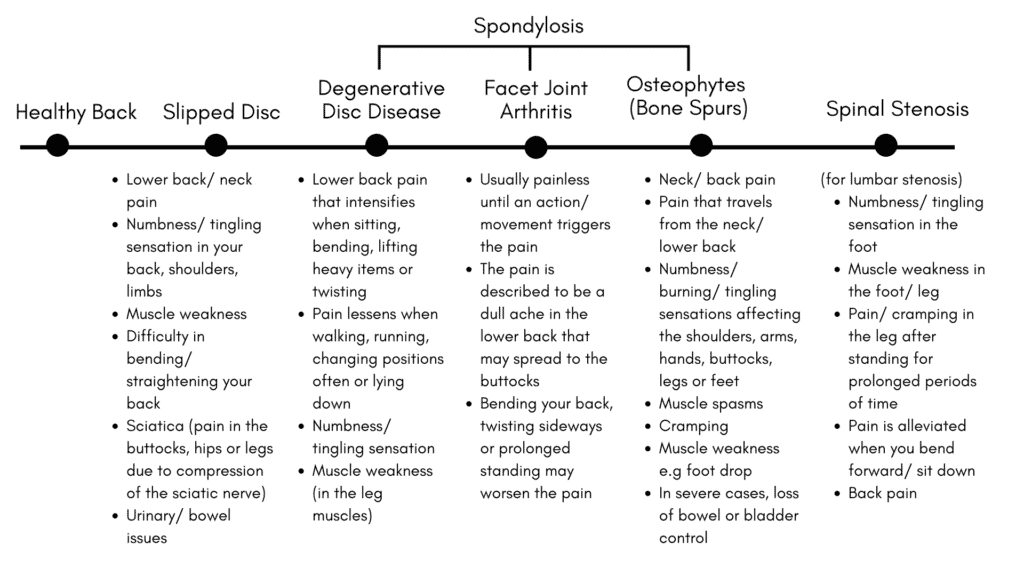

A. Traumatic
During trauma, fractures or dislocations in the spine may occur, leading to lower back pain.
B. Non-traumatic
Bad posture
Bad posture can cause excessive pressure to be exerted on your spine, leading to changes in your spine, pressure on your muscles, disks and joints, and nerve damage. Common forms of bad posture include:
■ Sitting slumped on your chair
■ Putting pressure on your stomach as you lie in bed
■ Sitting/ walking in a huddled manner – your shoulders/ arms are curved in
Correcting your posture when sitting/ standing/ walking can help to lessen the pressure on your spine, preventing lower back pain
● Lifting heavy objects, or not lifting safely

Back conditions are unique as they occur sequentially. The degree of pain is a continuous spectrum that ranges from a healthy back to spinal stenosis. Your condition may fall between the problems listed, so do refer to the diagram below to match the symptoms you have to the symptoms listed, to accurately estimate the condition of your back. For more information on the conditions listed in the diagram, read on.

| Condition | Description |
| Slipped disc | Your spinal column consists of bones stacked together, and each bone is cushioned by a disc. Discs help to absorb shock from your daily activities (e.g., walking, moving your limbs), thus protecting your bones. It also ensures that you maintain the stability of your back while still being able to move about with agility. Each disc has a gelatinous inner portion and a tougher outer portion. A slipped disc occurs when the inner portion pushes out through a tear in the outer portion of your disc. If the condition is severe, surgery may be required to remove the slipped disc. |
| Spondylosis | Spondylosis describes the general spinal degeneration, which may occur in the joints, discs, and/ or bones of the spine. This, therefore, encompasses degenerative disc disease, facet joint arthritis, and osteophytes. |
| Degenerative disc disease | Degenerative disc disease occurs when one or more of your discs gets worn out. Although this condition is closely related to age (as your disc may gradually wear out as you age), age is not directly the cause of this condition. Injuries sustained during sports, for example, may also lead to a degenerated disc. The discs in our spine normally allow us to move and bend our back without any issue. However, they wear out over time, and cannot protect our back well. When the discs deteriorate, it can lead to lower back pain. |
| Osteophytes (bone spurs) | Osteophytes (bone spurs) are small bone growths that often form in the joints (where bones meet each other) or on the bones of the spine. A bone spur becomes problematic when it starts to cramp up the space around a spinal nerve or the spinal cord, and/ or compress it. |
| Facet joint arthritis | Facet joint arthritis is a type of osteoarthritis that occurs between the facet joints, which are located in the back portion of your spine. The facet joint is almost always in motion, and it bears your weight, and it will be worn out over time, leading to facet joint arthritis. The cartilage breaks down, and moving your joints becomes harder with increased friction. |
| Spinal stenosis | Spinal stenosis is a condition in which the spaces within your spine (spinal canal) narrow, putting pressure on the nerves that travel through the spine and causing pain. This can occur throughout the entire spine. At the lumbar or lower back portion of the spine, this manifests as back pain, numbness, and cramps in the legs |
| Spondylolisthesis and spondylolysis | Spondylolisthesis occurs when a segment of bone falls out of alignment with the bones above and below it in the spinal column. This can result in pain and nerve symptoms. Spondylolysis is a form of spondylolisthesis when there is a fracture or crack in the bone(s) of your spine. It is common in young athletes who do sports such as gymnastics, which involves excessive or repetitive bending backward. Spondylolysis may not cause any symptoms but may result in back pain and nerve symptoms such as numbness and weakness. |
| Spinal infection | Spinal infections are rare but serious diseases that happen when the spinal tissue gets infected. Bacteria, fungi or viruses enter the bloodstream and affect the spinal discs, bones, and spinal cord. When your spine gets infected, your risk of spinal fractures/ cracks are much higher. In serious cases, you may even develop a spinal deformity. Symptoms include: Lower back painMay worsen at nightDoes not get better with restLoss of mobility/ range of moment (neck may be stiff)Fever/ sweating at nightLoss of appetiteSurgical wounds that do not heal/ have pus |
| Spinal tumours | The spine is a common site for tumors, especially in patients who have cancer affecting other organs. This can manifest as chronic lower back pain, that is unremitting and worsens at night. In severe cases, spinal deformities and nerve symptoms such as numbness, weakness can occur. |
If you want to book an appointment with Dr Yong Ren, please contact us at +65 98983595.
We will be happy to help you with any medical consultation you may need.
Lorem ipsum dolor sit amet consectetur adipiscing elit ut arcu a dignissim suscipit non ac eget tellus in nisl mauris nec.
